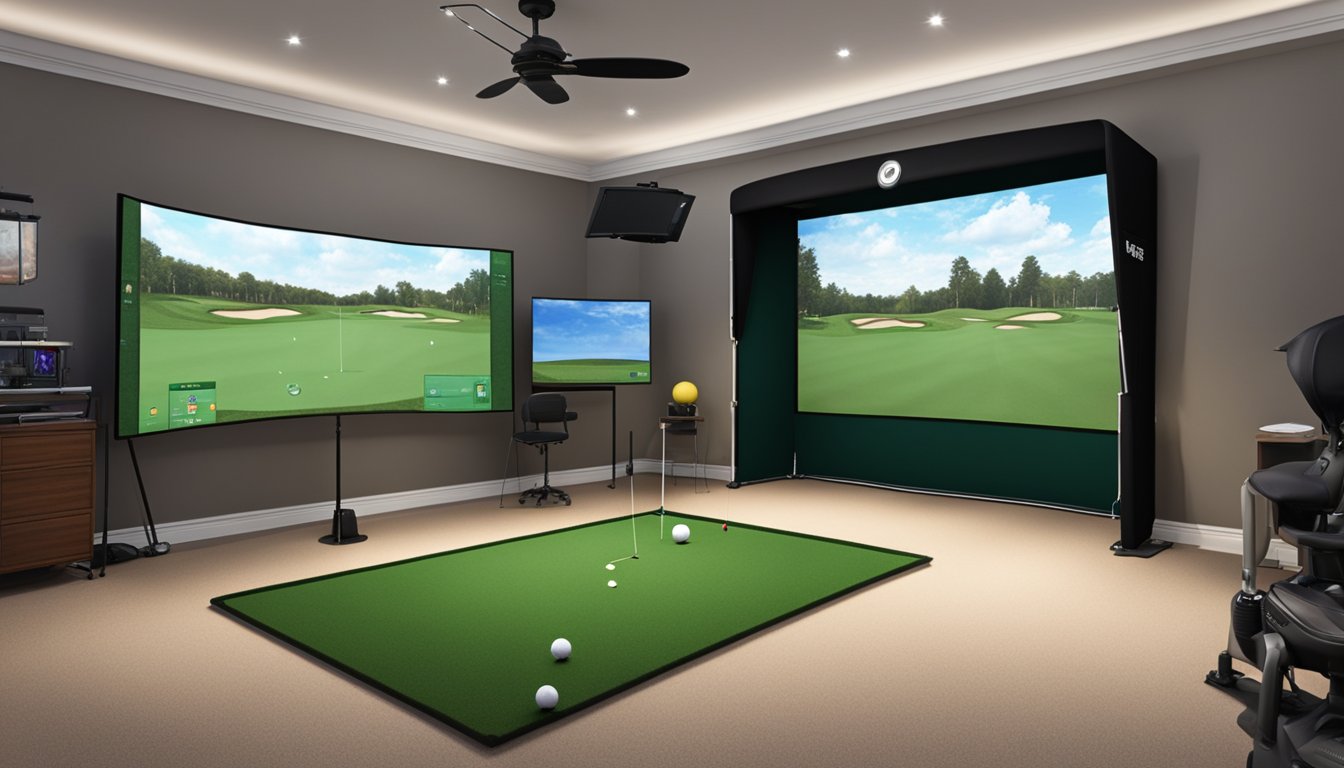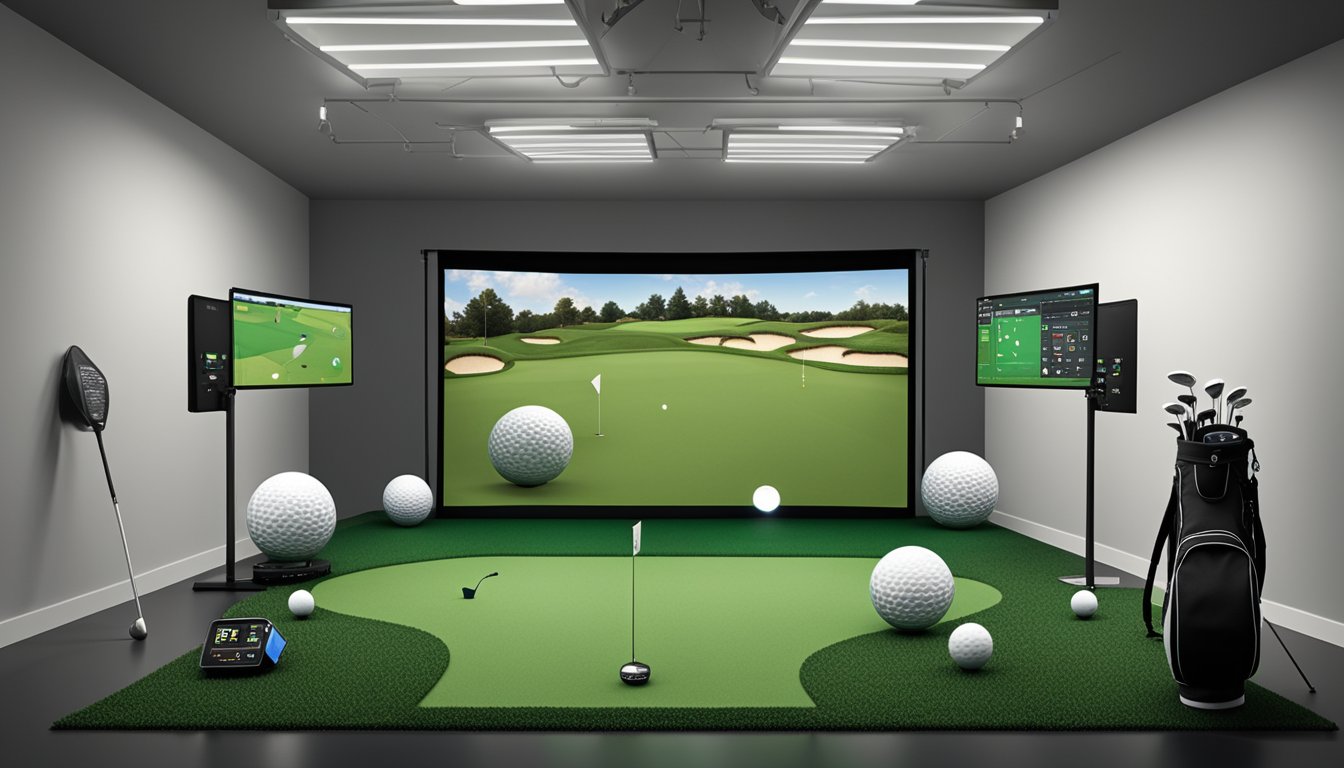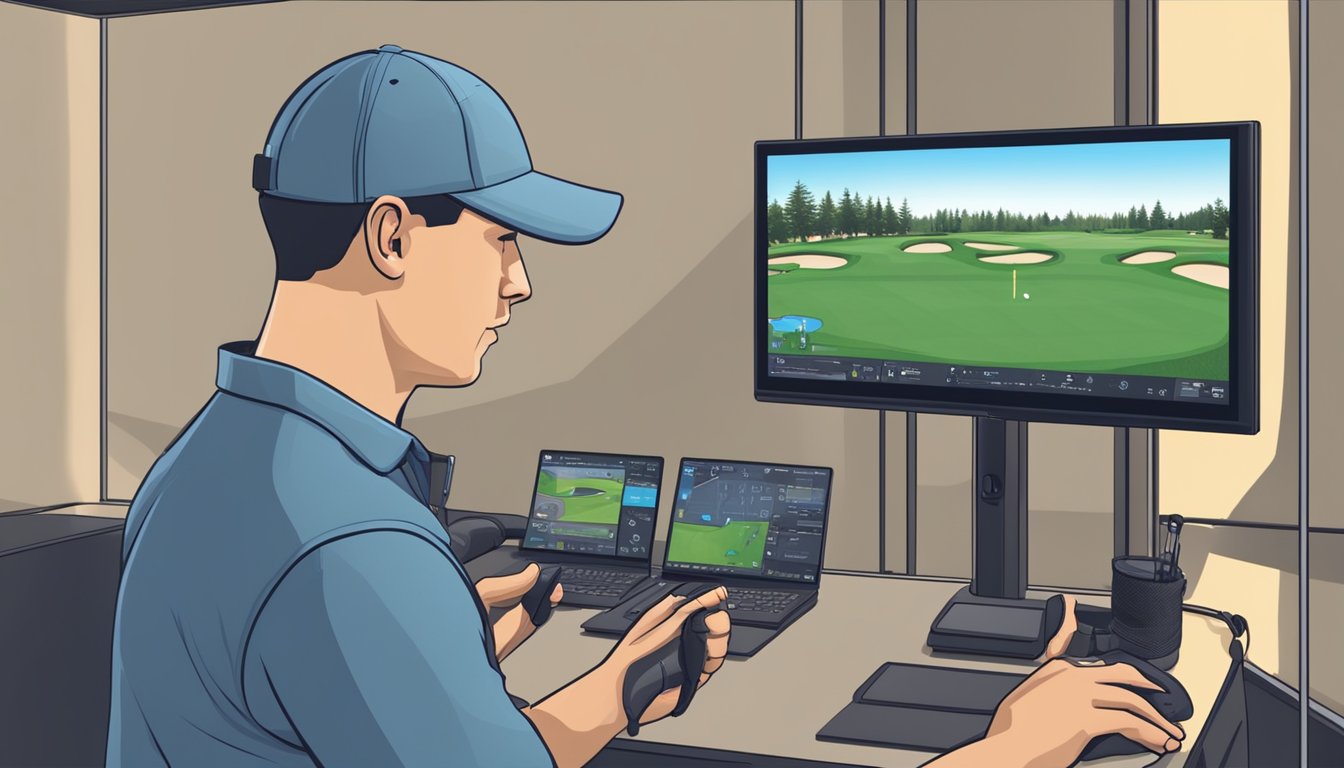Golf is a popular sport enjoyed by many, but it can be challenging to find time to hit the course. Fortunately, golf simulators offer a convenient and cost-effective way to practice your swing and improve your game. If you’re interested in purchasing a golf simulator, you may be wondering how much it will cost.
The cost of a golf simulator can vary widely depending on several factors, including the quality of the equipment, the size of the simulator, and the features it offers. Some golf simulators can cost as little as $1,000, while others can run upwards of $100,000. However, most people will spend between $8,000 and $25,000 on their golf simulator, according to Friendly Golfer.
Key Takeaways
- Golf simulators offer a convenient and cost-effective way to practice your swing and improve your game.
- The cost of a golf simulator can vary widely depending on several factors, but most people will spend between $8,000 and $25,000.
- When choosing a golf simulator, consider factors such as the quality of the equipment, the size of the simulator, and the features it offers.
Understanding Golf Simulators
https://www.youtube.com/watch?v=cAyVwphnYoM&embed=true
Golf simulators are an excellent way to practice your golf game indoors. They provide a realistic experience of playing golf in the comfort of your own home or office. A golf simulator consists of a launch monitor, hitting mat, projector, enclosure, impact screen, and software. Let’s take a closer look at each component of a golf simulator.
Launch Monitor
A launch monitor is a device that measures the ball’s speed, spin rate, launch angle, and direction. It is a crucial component of a golf simulator as it provides accurate data for shot analysis.
Hitting Mat
A hitting mat is a surface that simulates the feel of a real fairway. It is designed to absorb the impact of the clubhead and ball, reducing the risk of injury and damage to the club.
Projector
A projector displays the golf course and other visuals on the impact screen. It is an essential component of a golf simulator, and its cost can vary depending on the quality and brand.
Enclosure
An enclosure is a structure that surrounds the golfer and the simulator components. It provides a safe and secure environment for playing golf indoors. Enclosures come in various sizes and shapes, and some are customizable.
Impact Screen and Net
An impact screen is a specialized screen that is designed to withstand the impact of a golf ball. It is typically made of heavy-duty material and is placed in front of the projector. A net is also used to prevent the ball from flying off the screen.
Software
The software is the brain of the golf simulator. It controls the launch monitor, projector, and other components, providing a seamless experience for the golfer. Golf simulator software can vary in price, depending on the features and capabilities.
In summary, a golf simulator setup consists of several components, including a launch monitor, hitting mat, projector, enclosure, impact screen, and software. The cost of each component can vary depending on the brand, quality, and features. A golf simulator is an investment, but it can provide a fun and convenient way to practice your golf game indoors.
Types of Golf Simulators
When it comes to golf simulators, there are several types available on the market. Each type has its own unique features, advantages, and disadvantages. Here are some of the most popular types of golf simulators:
Entry-Level Golf Simulators
Entry-level golf simulators are the most affordable option for those who want to enjoy golf simulation at home. These simulators usually cost between $600 to $5,000. They are ideal for beginners who want to practice their swing and get a feel for the game. These simulators use basic sensors to track the ball and clubhead speed, but they may not provide accurate metrics such as launch angle and ball spin.
Mid-Range Golf Simulators
Mid-range golf simulators are a step up from entry-level simulators in terms of accuracy and features. They usually cost between $5,000 to $15,000 and offer a more realistic golfing experience. These simulators use advanced sensors to track swing data such as launch angle, ball speed, and spin rate. They also come with a variety of simulated courses and gameplay options.
High-End Golf Simulators
High-end golf simulators are the most expensive option and offer the most realistic golfing experience. They usually cost between $15,000 to $40,000 and are used by professional golfers and PGA tour players. These simulators use advanced sensors and software to provide accurate data parameters such as launch angle, ball speed, spin rate, and more. They also come with a wide range of simulated courses and gameplay options.
DIY Golf Simulators
DIY golf simulators are a popular option for those who want to build their own simulator at home. These simulators require some technical knowledge and space requirements, but they can be customized to fit your needs and budget. DIY simulators can cost anywhere from a few hundred dollars to several thousand dollars depending on the components used.
Commercial Golf Simulators
Commercial golf simulators are designed for use in practice ranges, golf courses, and other commercial settings. These simulators are usually high-end and offer a wide range of features and options. They can cost anywhere from $20,000 to $100,000 or more depending on the brand and features.
Whether you’re looking for an affordable home golf simulator or a high-end commercial option, there are plenty of choices available to fit your needs and budget. Just be sure to consider factors such as accuracy, metrics, simulated gameplay, and warranty before making your final decision.
Cost Factors of Golf Simulators
https://www.youtube.com/watch?v=wHvCLnmPiQE&embed=true
When considering purchasing a golf simulator, there are several cost factors to take into account. Here are some of the most important ones to keep in mind:
Options and Budget
Golf simulators come in a wide range of options and prices, from basic to high-end models. Your budget will determine the level of quality and features you can afford. It is important to set a realistic budget and stick to it.

Golf Simulator Cost and Price Range
« Best Amazon Basics Golf Bags: Affordable and High-Quality Options
Best Adams Hybrids for Your Golf Game »
The cost of a golf simulator can vary widely depending on the brand, features, and quality. Prices for a Full Swing golf simulator start around $40,000 and go up to $90,000, while prices for a SkyTrack simulator start around $1,900 and go up to $7,000. Golf simulator costs start at $600 and can even go higher than $60,000.
Value and Quality
It is important to consider the value and quality of the golf simulator you are purchasing. A high-quality simulator may have a higher price tag, but it will provide a more accurate and realistic experience.
Affordable Golf Simulator and Home Golf Simulator Cost
If you are on a tight budget, there are affordable golf simulator options available. A home golf simulator will range in cost from as low as $1,000 up to $100,000, but most will spend between $8,000 to $25,000 on their golf simulator. It is important to consider the quality and features of the simulator when making a purchase.
Package Deal and Installation
Many golf simulators come as a package deal, which can include the simulator, enclosure, hitting mat, projector, and screen. It is important to consider the installation costs, as well as any additional costs for electrical work or building modifications.
Accessories and Additional Costs
Accessories such as golf clubs, balls, and tees will add to the overall cost of your golf simulator. Additionally, there may be additional costs for software updates, maintenance, and repairs.

Golf Simulator Components and Golf Simulator Projector Costs
The components of the golf simulator, such as the projector, screen, and launch monitor, will also affect the overall cost. Higher quality components will provide a more accurate and realistic experience, but will also come with a higher price tag.
Golf Simulator Software Costs
The software used with the golf simulator will also affect the overall cost. Some simulators come with built-in software, while others require additional software to be purchased separately. It is important to consider the cost of the software when making a purchase.
In conclusion, when considering purchasing a golf simulator, it is important to consider all of the cost factors involved to ensure that you are getting the best value for your money.
Choosing the Right Golf Simulator for Your Needs
https://www.youtube.com/watch?v=2A80NoFg-Fw&embed=true
Investing in a golf simulator can be a great way to improve your game without leaving the comfort of your home. However, with so many options available, it can be overwhelming to choose the right one for your needs. Here are some factors to consider when choosing a golf simulator:

Budget
Golf simulators can range in price from a few hundred dollars to tens of thousands of dollars. Determine your budget before making a purchase. Keep in mind that while affordable golf simulators may be tempting, they may not provide the accuracy and features that more expensive options offer.
Abilities
Consider your skill level and what you want to achieve with the simulator. If you’re a beginner, you may not need all the bells and whistles that a more advanced golfer would want. However, if you’re serious about improving your game, you may want to invest in a simulator with more advanced features.
Components
A golf simulator is made up of several components, including a screen or projector, a launch monitor, and software. Make sure you understand what components are included with the simulator you’re considering, as well as any additional components you may need to purchase separately.
Projector Costs
The cost of the projector for your golf simulator can be a significant expense. Depending on the quality and features you want, a projector can cost anywhere from a few hundred dollars to several thousand dollars.
Software Costs
The software you use with your golf simulator can also vary in price. Some simulators come with built-in software, while others require you to purchase it separately. Make sure you understand what software is included with the simulator you’re considering, as well as any additional software you may need to purchase.
Full Swing Golf Simulator Cost
Full Swing Golf Simulators are one of the more popular options on the market. Prices for a Full Swing golf simulator start around $40,000 and go up to $90,000. Installed prices start around $50,000. Keep in mind that this is a high-end option, and there are more affordable golf simulators available.
Affordable Golf Simulators
If you’re on a budget, there are affordable golf simulators available. Prices for a home golf simulator will range from as low as $1,000 up to $25,000, but most will spend between $8,000 to $15,000 on their golf simulator. While these simulators may not have all the features of more expensive options, they can still provide an accurate and enjoyable golfing experience.
Overall, choosing the right golf simulator for your needs requires careful consideration of your budget, abilities, and goals. By taking the time to research and compare options, you can find a simulator that will help you improve your game and enjoy golfing from the comfort of your own home.
Installation and Maintenance of Golf Simulators
Once you have selected the golf simulator that best meets your abilities and budget, it is time to consider the installation and maintenance of the simulator.

Installation
Most golf simulators come with detailed installation instructions, but if you are not comfortable with DIY installations, you can hire a professional installer to do the job for you. Some companies, like SkyTrak and Full Swing Golf, offer installation services for an additional cost.
When installing a golf simulator, it is important to consider the space requirements. You will need enough space to swing your clubs comfortably and to accommodate the landing turf. You will also need to ensure that there is enough clearance for the ball to travel without hitting any objects.
Maintenance
Proper maintenance is crucial to ensure that your golf simulator lasts for a long time. Here are some tips to keep your simulator in good condition:
-
Clean the simulator regularly to prevent dust and debris from accumulating on the sensors and cameras.
-
Check the landing turf for wear and tear and replace it if necessary.
-
Keep the simulator software updated to ensure that it runs smoothly and efficiently.
-
Check the data parameters regularly to ensure that the simulator is providing accurate swing data.
-
If you encounter any issues with the simulator, refer to the warranty information provided by the manufacturer.
Additional Costs
Aside from the initial cost of the golf simulator, there may be additional costs associated with accessories and software. For example, you may need to purchase an HDMI cable to connect the simulator to your TV or projector.
Some simulators, like the SkyTrak and Approach R10, require additional accessories like a hitting net or projector mount.

In addition, some simulators require a subscription to access simulated courses or to use certain software features. For example, the E6 Connect software used by some simulators requires a monthly subscription fee.
Frequently Asked Questions
- How much does it cost to install a golf simulator?
The cost of installation varies depending on the company and the complexity of the installation. Some companies offer installation services for an additional cost, while others provide detailed instructions for DIY installations.
- What are the space requirements for a golf simulator?
The space requirements vary depending on the simulator, but most require a minimum of 10 feet by 10 feet of space.
- What is the warranty on a golf simulator?
The warranty varies depending on the manufacturer, but most offer a one- to three-year warranty on their simulators.
- What is the cost of additional accessories and software?
The cost of additional accessories and software varies depending on the company and the product. Some accessories, like an HDMI cable, are relatively inexpensive, while others, like a hitting net, can cost several hundred dollars.

Frequently Asked Questions
https://www.youtube.com/watch?v=t0iRzoG8tXM&embed=true
What is the average cost of a golf simulator?
The cost of a golf simulator can vary widely depending on the quality, features, and brand. According to Yardstick Golf, the cost of a commercial golf simulator can range from $5,200 to $100,000. On the other hand, a home golf simulator can cost anywhere between $1,000 to $100,000. The average cost for a good quality home golf simulator is around $20,000.
Where can I find affordable golf simulators for sale?
There are many online stores and retailers that sell golf simulators at affordable prices. Some of the popular stores include Amazon, eBay, and Best Buy. You can also check out the official websites of golf simulator manufacturers, such as SkyTrak, OptiShot, and ProTee. These manufacturers often offer discounts and promotions on their products.
How much does it cost to rent a golf simulator per hour?
The cost of renting a golf simulator per hour can vary depending on the location and the quality of the simulator. On average, the cost can range from $30 to $60 per hour. However, some high-end simulators can cost as much as $100 per hour. Some golf clubs and indoor golf centers may offer discounts for group bookings or off-peak hours.
What is the best golf simulator for home use?
There are many great golf simulators available for home use, each with their own unique features and benefits. Some popular options include SkyTrak, OptiShot, and ProTee. The best golf simulator for you will depend on your budget, space, and personal preferences.
Are golf simulators worth the investment?
Golf simulators can be a great investment for golf enthusiasts who want to improve their game and practice year-round. They offer a realistic and immersive golf experience, and can be used for entertainment and socializing as well. However, they can be expensive, so it’s important to consider your budget and goals before making a purchase.
Can a golf simulator be installed in a residential property?
Yes, golf simulators can be installed in a residential property, provided that there is enough space and proper ventilation. You will also need to consider the noise level and potential damage to the property. It’s best to consult with a professional installer to ensure that the simulator is installed safely and properly.










